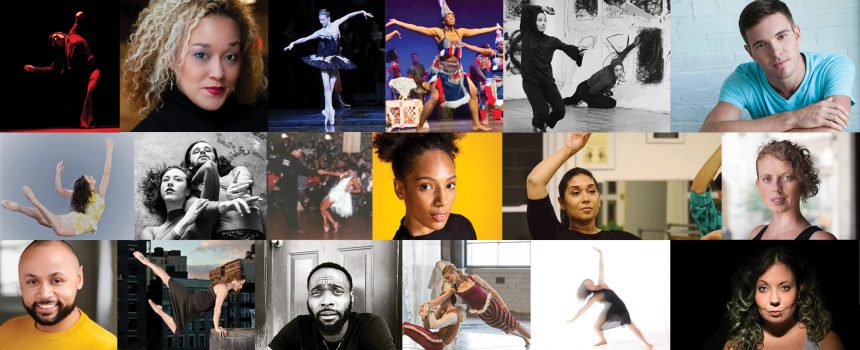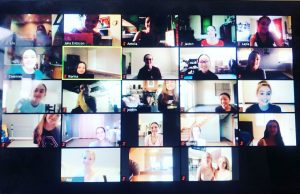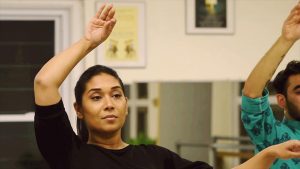Connecting in New Ways in the Time of COVID-19

Since March 2020, Pittsburgh Ballet Theatre (PBT) School has transformed ballet learning into a virtual experience. Home Zoom classes became the norm for the end of the 2019-2020 school year, and continued into the fall even as studios reopened with limited capacity. During the pandemic, PBT School Instructor Jamie Erin Murphy seized the opportunity in remote learning as a chance to connect PBT School Pre-professional students (ages 13+) to a rich array of local artists and teachers.
In September 2020, Murphy created the Pittsburgh Connections Class Series, calling on the relationships she forged in her career as a modern, contemporary and jazz instructor for PBT School, accessibility program instructor for PBT’s education department, and freelance artist in the Pittsburgh dance community. Each Saturday, Pre-professional students – who spent most of their week in the studio – were digitally introduced to one of 18 guest teachers and artists, ranging in style from contemporary ballet and jazz to West African, Latin ballroom and Indian Kathak.
Guest artists slowdanger, a multidisciplinary performance entity co-founded by Anna Thompson and Taylor Knight, feel that exposure to diversified styles of dance is vital to the learning experience – especially within a ballet-focused curriculum.
“Codified dance training focused on Western forms of dance can often view or categorize embodied experiences through a hierarchical lens,” they said. “As we continue to examine how our worlds must be reoriented towards more equitable change, this series provided young dancers with a broad range of moving experiences. This is essential in setting young dancers up for the many possibilities that are currently unfolding within the dance field.”

“The breadth and depth of what other dance forms have to offer can be so enriching and expansive to one’s ballet training and to the formation of one’s burgeoning artistic voice,” added Former PBT Principal Julia Erickson. “Even if these students go on to join classical ballet companies, they will absolutely utilize these skills as they dance myriad styles within the scope of a modern day ballet company repertory.”
While learning new ideas and dance styles, students and teachers were also exploring what it meant to be physically apart. Despite the distance, guest artist Gia Cacalano still felt like connections were strong. Cacalano, a movement and visual artist, choreographer, instant composer, educator and performer, presented a unique class exploring a keener sensory awareness using proprioception, interoception and experiential anatomy.
“It was an honor to connect with the students and be challenged within the ‘limitations’ of our current situation in distance,” Cacalano said. “Our greatest opportunities to invent, evolve, explore and create derive from the challenges and perceived obstacles in which to problem solve.”
Shannon Murphy, a dance artist and educator living in Philadelphia, also used her class to connect the students to their body. Shannon is a certified practitioner of the Franklin Method, a somatic practice that combines Dynamic Neuro-cognitive Imagery™, functional anatomy and movement practices – and she’s Jamie Erin Murphy’s sister. Her class utilized the constraints of learning remotely by focusing on slowing down, noticing bodily sensations and sharing experiences. After a COVID-influenced year, it helped to relieve stress, take a break from the screens and focus inwardly in the moment.
“A career in dance has surprises and opportunities that change our lives just as much as the disappointments that make us question everything,” Shannon said. “Today’s dancer is a dancer that responds to the stresses of life, that takes care of themselves as much as they care for the dancer next to them, and can still see and feel the magic of dance. I hope that we can reflect on this past year from the future and understand that this did not ruin us but gave us skills to adapt, heal and thrive.”
“I think it’s important for not only the students to be able to learn from [the guest artists],” Jamie Erin Murphy said, “but also the staff and the organization can learn and grow from these different artists explaining their backgrounds and what we don’t know about what they do and what’s happening in Pittsburgh.”

Guest artist Naina Green, founding director of Courtyard Dancers of Pittsburgh, connected to PBT staff and faculty as well as PBT School students. She shared the history and future of Kathak dance around the world and in Pittsburgh through a virtual lunch and learn hosted by the PBT Equity Project Transformation Team, which strives to discuss and implement Inclusion, Diversity, Equity and Accessibility (IDEA) practices into the organization.
Katrina Chen, a 16-year-old Level 8 student from San Francisco, recognized the unique opportunity learning from Pittsburgh Connections Class Series guest teachers and artists.
“Not only does learning from a different dancer enhance one’s personal repertoire,” Chen said, “but learning the deep rooted culture that is embedded within the dance form is a way of honoring and passing down the tradition through dance. I am more intrigued with the sharing of cultural experiences through dance as a way to educate myself on another’s culture. The more we as a community can respect each other’s differences, the more we are able to unite as a society.”
In addition to learning different styles of dance, Murphy hoped the series would bring greater awareness to the dance scene outside of the PBT bubble. PBT School is eager to make the Pittsburgh Connections Class Series a Pre-professional tradition – a milestone for PBT School students in the Student Division to look forward to as they become Pre-professionals.
The series serves as a connection between students and teachers, staff and artists, and PBT and the community. Guest artists, such as Shanna Simons Dance collaborators Shanna Simons and Brady Sanders, and Michele de la Reza of Attack Theatre, will be part of Open Air: A Series in Celebration of the Performing Arts, a two-week outdoor series featuring more than 20 local performing arts organizations.
After a year of darkened theaters, supporting Pittsburgh’s performing arts community is more crucial than ever.
“It is getting the awareness out for our dance community that has struggled in the last year,” Murphy said. “We don’t have performances. If we get more awareness of what is happening with smaller companies or independent artists in the city, that’s huge for the dance community here. That’s one new face in an audience and or watching an online performance.”
Q&A – The Students’ Experience
Why is it important for you as a student to learn from dancers of different voices, styles and cultures?
Taking classes in such a wide selection of styles has the power to develop students’ ballet dancing. Different teachers may have a new way of explaining an idea that didn’t make sense before, make you think about your dancing in a new way, challenge you to really examine your relationship with the space around you. Every Pittsburgh Connections Class I attended, I was amazed at how each teacher brought something new to the table; every class added a new element to my dancing as well as myself as a person.
– Amelia Bandy, PBT School Level 6 student from the Greater Pittsburgh Area
Why do you think this type of learning and networking experience is important for ballet-focused students?
Ballet-focused students are usually very keen on becoming professional ballet dancers specifically. For some, this path is perfect. But, even among the small community of Pre-professional dancers, many will go into companies or performances that are not strictly ballet. It is important for these students to be exposed to other styles and artists in their area that can help expand their interest and artistic palette for non-classical styles. This way the students can start interacting with outside influences early on and enter other artistic communities in their area. They can then take part in educational opportunities and watch performances in other styles that they might end up auditioning for and performing in later in their careers.
– Caterina Baker, PBT School Level 8 student from Rochester, NY
Did you find connections with different dance styles throughout the series that you hadn’t experienced before?
Yes. I have definitely found many styles of dance that I enjoyed very much doing that I had never done before, like commercial jazz/musical theatre, learning how to move my body and help it heal if it’s sore, and improv class. These were some of my favorite classes that we learned, because they all taught me something that really interested me.
– Brady Allen, PBT School Level 8 student from Pleasantville, NY
Guest Artists Involved:
Chrisala Brown
Gia Cacalano
Michia Carmack
Kaitlin Dann
Michele de la Reza
Julia Erickson
Naina Green
Madeline Kendall
Kiki Lucas
James Washington Manning
Jamie Erin Murphy
Shannon Murphy
Pearlann Porter
Mario Quinn
Brady Sanders
Shana Simmons
Rozana Sweeney
Anna Thompson/Taylor Knight
